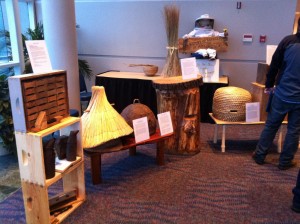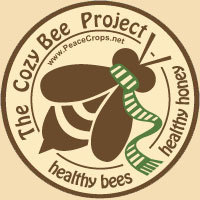I was starting to feel a little jealous about the scholarship that Emily won to go to the Young Farmers’ Conference, even though I’m so happy for her. Then, out of the blue, I won my own scholarship to the state-wide annual beekeeping conference! It turns out that our local club got a free pass, and they decided in the end that I should go. To make it even better, this year the conference is in Seaside, just 40 minutes north of here, so I didn’t need airfare or a hotel room.
 It was fun to see so many beekeepers (over 200) from all over the Pacific Northwest. There were hobbyists with one or two hives to commercial guys with one or two thousand. I saw 10-year-old kids there for Bee School and several beekeepers that I KNOW are in their eighties. There were PhD lecturers from Delaware, Luisiana, and Oregon. I even saw seminars on apitherapy (using hive products for medicinal purposes) and mead making (which I am totally going to get back into). They even had a display of traditional beehives throughout history, including a skep.
It was fun to see so many beekeepers (over 200) from all over the Pacific Northwest. There were hobbyists with one or two hives to commercial guys with one or two thousand. I saw 10-year-old kids there for Bee School and several beekeepers that I KNOW are in their eighties. There were PhD lecturers from Delaware, Luisiana, and Oregon. I even saw seminars on apitherapy (using hive products for medicinal purposes) and mead making (which I am totally going to get back into). They even had a display of traditional beehives throughout history, including a skep.
The conference was big, but still small enough that you could go up to anyone after their lecture and have a discussion with them. I talked for a while with Darren Gordon of House of Bees about his design for a Warré hive. He builds and sells VERY nicely made top-bar hives, a type that is not as well known as the traditional Langstroth hive. I made one last summer, but too late to catch any more bees to put in it. The Abbey Warré was very specific about the dimension of his hive in the book he wrote almost a century ago, and I changed them somewhat to be more efficient in their use of modern dimensional lumber. After some discussion, Darren felt that the changes I made were in noncritical areas that wouldn’t adversely affect the overall quality of the hive. Good news! But I guess we’ll know for sure next spring, when I put some bees into it.
I was pleasantly surprised to see that a lot of the lectures were about sustainability; turns out that beekeepers are as concerned about the environment as the hippie farmers we normally hang out with. In his lecture on sustainable apiculture, Dr. Steve Shepard from Washington State University talked about the “true costs” of cheap agriculture. Farmers in places like Nebraska and Missouri use petrochemical fertilizers to produce record amounts of grains cheaply, then the residue from these chemicals washes into the Mississippi watershed and the Gulf of Mexico, causing hypoxia in the coastal regions and killing off the marine life, which in turn causes damage to the commercial fisheries. Does saving money making corn justify the costs of subsequent loss of jobs and food resources downstream? Beekeepers are equally concerned about systemic pesticides and GMOs (Genetically Modified Organisms). Besides a general level of unease about sticking fish DNA into plants, there is evidence to suggest that these cheap ways of increasing grain production are causing Colony Collapse Disorder, a mysterious disease responsible for the nationwide loss of nearly half our bee colonies in the last decade. Bees are in danger, and projections indicate that if the trend is not reversed, honeybees could cease to exist by 2035. This is not just a matter of no more honey; honeybees pollinate much of the groceries you see in the grocery store.
Speaking of honey, I also learned some disturbing news about China. We’ve banned Chinese honey in the US for years, in part because its low price would put US producers out of business, but more because it’s poisonous… among other things, they use a known carcinogen (chloramphenicol) to control hive diseases, and some of their processing equipment has lead parts, leading to traceable levels of both in their shipped honey. But apparently, their product is still making it into your breakfast cereals and honey bears because they’ve been selling it to India, Malaysia, and even Australia where it is repackaged and sent on to American ports and bought by the train car load by large scale food companies. The whole things is like an espionage novel, and you can read more about it in this fascinating article in Food Safety News. I remind you once again: if you want to be sure your honey is safe, know your beekeeper. Not even your legislators are going to protect you; for some reason food labeling laws in the US do not require honey to show a list of ingredients if it’s at least 51% honey. Much of what you see on the shelf is “funny honey” with a lot of water or high fructose corn syrup in it.
It was a great way to spend a weekend learning about bees, even if I did miss the only two sunny days we’re going to have for months.


